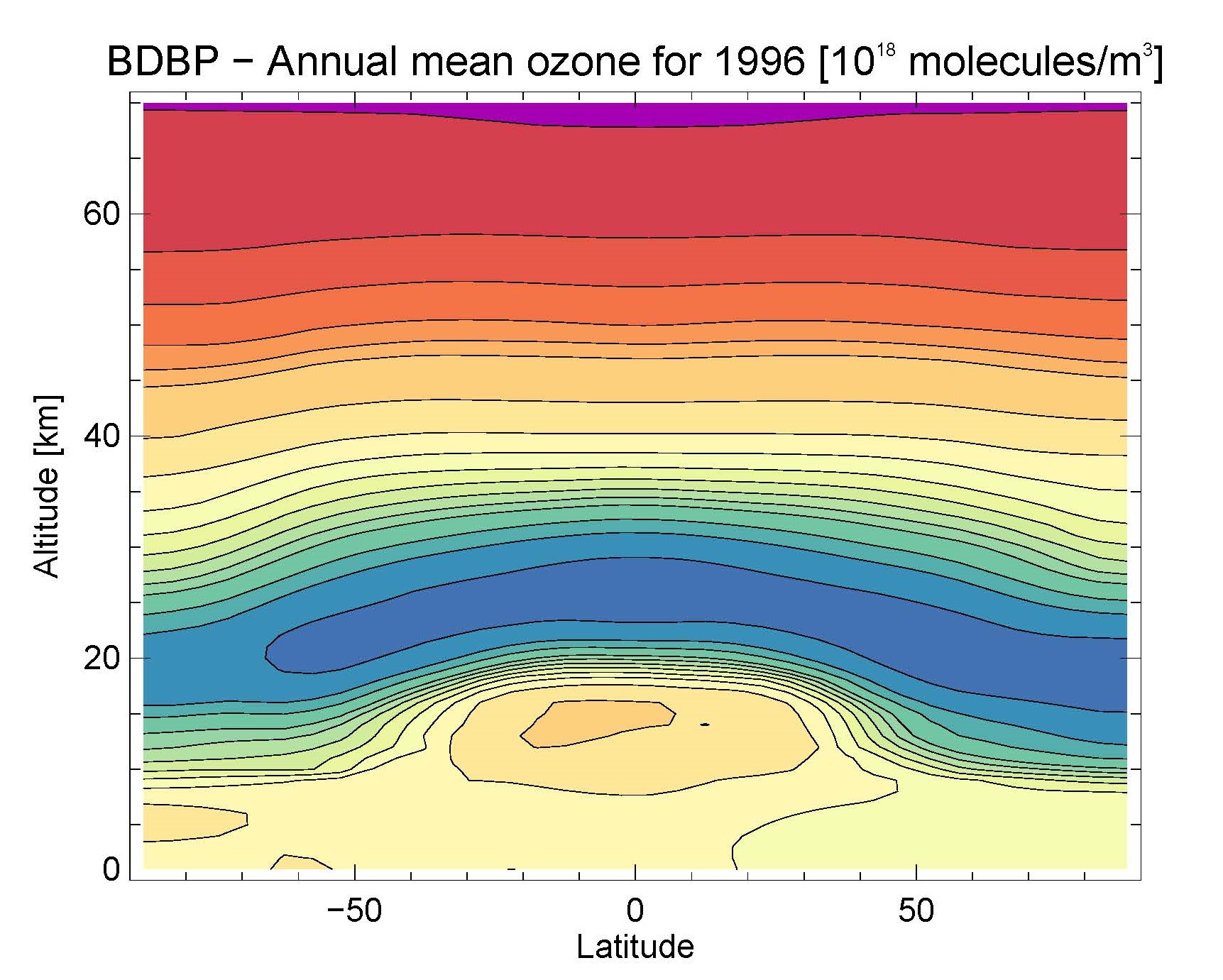NOAA Climate Data Record (CDR) of Zonal Mean Ozone Binary Database of Profiles (BDBP), version 1.0
Ozone - ESRL; NOAA Ozone ESRL CDR
This NOAA Climate Data Record (CDR) of Zonal Mean Ozone Binary Database of Profiles (BDBP) dataset is a vertically resolved, global, gap-free and zonal mean dataset that was created with a multiple-linear regression model. The dataset has a monthly resolution and spans the period 1979 to 2007. It provides global product in 5 degree zonal bands, and 70 vertical levels of the atmosphere. The regression is based on monthly mean ozone concentrations that were calculated from several different satellite instruments and global ozone soundings. Due to the regression model that was used to create the product, various basis function contributions are provided as unique levels or tiers. To understand the different contributions of basis functions, the data product is provided in five different "Tiers". - Tier 0: raw monthly mean data that was used in the regression model - Tier 1.1: Anthropogenic influences (as determined by the regression model) - Tier 1.2: Natural influences (as determined by the regression model) - Tier 1.3: Natural and volcanic influences (as determined by the regression model) - Tier 1.4: All influences (as determined by the regression model, CDR variable)
Dataset Citation
- Cite as: Rosenlof, Karen, Bodeker, G. E., Hassler, B., and NOAA CDR Program: NOAA Climate Data Record (CDR) of Zonal Mean Ozone Binary Database of Profiles (BDBP), Version 1.0. [indicate subset used]. NOAA National Climatic Data Center. doi:10.7289/V56M34RT [access date].
- Please refer to Credit tab for full citation information.
Dataset Identifiers
- doi:10.7289/V56M34RT
- NCEI DSI 3643_01
- gov.noaa.ncdc:C00930
ISO 19115-2 Metadata
gov.noaa.ncdc:C00930
| Download Data |
|
| Distribution Formats |
|
| Ordering Instructions | Contact NCEI for other distribution options and instructions. |
| Distributor |
NOAA National Centers for Environmental Information ncei.info@noaa.gov |
| Dataset Point of Contact | NOAA Climate Data Record Program Office DOC/NOAA/NESDIS/NCEI > National Centers for Environmental Information, NESDIS, NOAA, U.S. Department of Commerce +1 (828) 271-4800 ozone_esrl_contacts@noaa.gov |
| Time Period | 1979 to 2007 (time interval: 1-month) |
| Spatial Bounding Box Coordinates |
West: -180.0
East: 180.0
South: -90.0
North: 90.0
|
| Spatial Coverage Map |
| Dataset Information |
|
| General Documentation |
|
| Processing Documents |
|
| Associated Resources |
|
| Publication Dates |
|
| Edition | Version 1.0 |
| Data Presentation Form | Digital table - digital representation of facts or figures systematically displayed, especially in columns |
| Dataset Progress Status | Complete - production of the data has been completed |
| Data Update Frequency | As needed |
| Purpose | The dataset provides advanced scientific researchers a high quality Climate Data Record (CDR) of ozone at multiple altitude or pressure levels. The monthly means that are the basis for the regression model can also be used for ozone data analyses directly, e.g. trend studies. However, these are not available for all months of the period 1979 to 2007, and not all latitude bands. |
| Use Limitations |
|
| Dataset Citation |
|
| Cited Authors |
|
| Originators |
|
| Principal Investigators |
|
| Collaborators |
|
| Publishers |
|
| Theme keywords |
Global Change Master Directory (GCMD) Science Keywords
|
| Data Center keywords |
Global Change Master Directory (GCMD) Data Center Keywords
|
| Platform keywords |
Global Change Master Directory (GCMD) Platform Keywords
|
| Instrument keywords |
Global Change Master Directory (GCMD) Instrument Keywords
|
| Place keywords |
Global Change Master Directory (GCMD) Location Keywords
|
| Project keywords |
Keyword Thesaurus Title
|
| Stratum keywords |
Global Change Master Directory (GCMD) Location Keywords
|
| Use Constraints |
|
| Access Constraints |
|
| Fees |
|
| Lineage information for: dataset | |
|---|---|
| Lineage Statement | The data were produced by NOAA ESRL Chemical Sciences Division (CSD), University of Colorado CIRES, and Bodeker Scientific and are archived at the NOAA National Climatic Data Center (NCDC). Updates to extend the Ozone ESRL CDR data set to the present are anticipated, pending adequate funding. For more information, see associated processing documentation. |
| Processor |
|
| Processing Steps |
|
| Processing Documents |
|
| Source Datasets |
|
| Lineage information for: repository | |
|---|---|
| Processing Steps |
|
Last Modified: 2023-08-10
For questions about the information on this page, please email: ncei.info@noaa.gov
For questions about the information on this page, please email: ncei.info@noaa.gov

